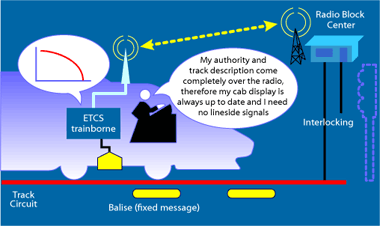Search
European Rail Traffic Management System
The European Rail Traffic Management System (ERTMS) is an initiative backed by the European Union to enhance cross-border interoperability and the procurement of signalling equipment by creating a single Europe-wide standard for train control and command systems.
ERTMS has two basic components
1- ETCS, the European Train Control System, is an automatic train protection system (ATP) to replace the existing national ATP-systems;
2- GSM-R, a radio system for providing voice and data communication between the track and the train, based on standard GSM using frequencies specifically reserved for rail application with certain specific and advanced functions.
The European Railway Traffic Management System (ERTMS) is a major industrial project developed by eight UNIFE members – Alstom Transport, Ansaldo STS, AZD Praha, Bombardier Transportation, Invensys Rail, Mermec, Siemens Mobility and Thales – in close cooperation with the European Union, railway stakeholders and the GSM-R industry.
ERTMS aims at replacing the different national train control and command systems in Europe. The deployment of ERTMS will enable the creation of a seamless European railway system and increase European railway’s competitiveness.
A unique train control system for Europe and beyond
As a unique European train control system, ERTMS is designed to gradually replace the existing incompatible systems throughout Europe. This will bring considerable benefits to the railway sector as it will boost international freight and passenger transport.
In addition, ERTMS is arguably the most performant train control system in the world and brings significant advantages in terms of maintenance costs savings, safety, reliability, punctuality and traffic capacity. This explains why ERTMS is increasingly successful outside Europe, and is becoming the train control system of choice for countries such as China, India, Taiwan, South Korea and Saudi Arabia.
By making the rail sector more competitive, ERTMS helps to level the playing field with road transport and ultimately provides significant environmental gains.
Signaling levels
The ERTMS “levels” define different uses of ERTMS as a train control system, ranging from track to train communications (Level 1) to continuous communications between the train and the radio block centre (Level 2), and moving block technology (Level 3, which is in a conceptual phase).
1- Eurobalise without infill
- Overlay to Existing Signaling System.
- Movement Authorities through Eurobalise.
- Train Integrity & Position by Track Circuit.
2- Eurobalise + infill (euroloop, radio, or extra balises)
- Overlay to Existing Signaling System.
- Movement Authorities through Eurobalise.
- Train Integrity & Position by Track Circuit.
3- Eurobalise + Euroradio (GSM-R) + Radio Block Center
- No more Trackside Signals Required.
- Movement Authorities through GSM-R.Train Position via Eurobalise.
4- Eurobalise + Euroradio (GSM-R) + Radio Block Center
- Movement Authorities through GSM-R.Authorities through Eurobalise.
- Train Position via Eurobalise.
- Train Integrity Onboard.
- Moving Block.
Benefits
- Increased capacity on existing lines and a greater ability to respond to growing transport demands: as a continuous communication-based signalling system, ERTMS reduces the headway between trains enabling up to 40% more capacity on currently existing infrastructure;
- Higher speeds: ERTMS allows for a maximum speed up to 500 km/h;
- Higher reliability rates: ERTMS may significantly increase reliability and punctuality, which are crucial for both passenger and freight transport;
- Lower production costs: one proven, harmonised system is easier to install, maintain and manufacture making railway systems more competitive;
- Reduced maintenance costs: With ERTMS level 2, trackside signalling is no longer required, which considerably reduces maintenance costs;
- An opened supply market: customers will be able to purchase equipment for installation anywhere in Europe and all suppliers will be able to bid for any opportunity. Trackside and onboard equipment may be made by any of the six ERTMS suppliers, which makes the supply market more competitive;
- Reduced contract lead time due to the significant reduction of process engineering;
- Simplified approval process in Europe and greatly reduced certification costs traditionally associated with the introduction of new systems;
- Improved safety for passengers
ERTMS Corridors
Videos:
Source: ertms.net





